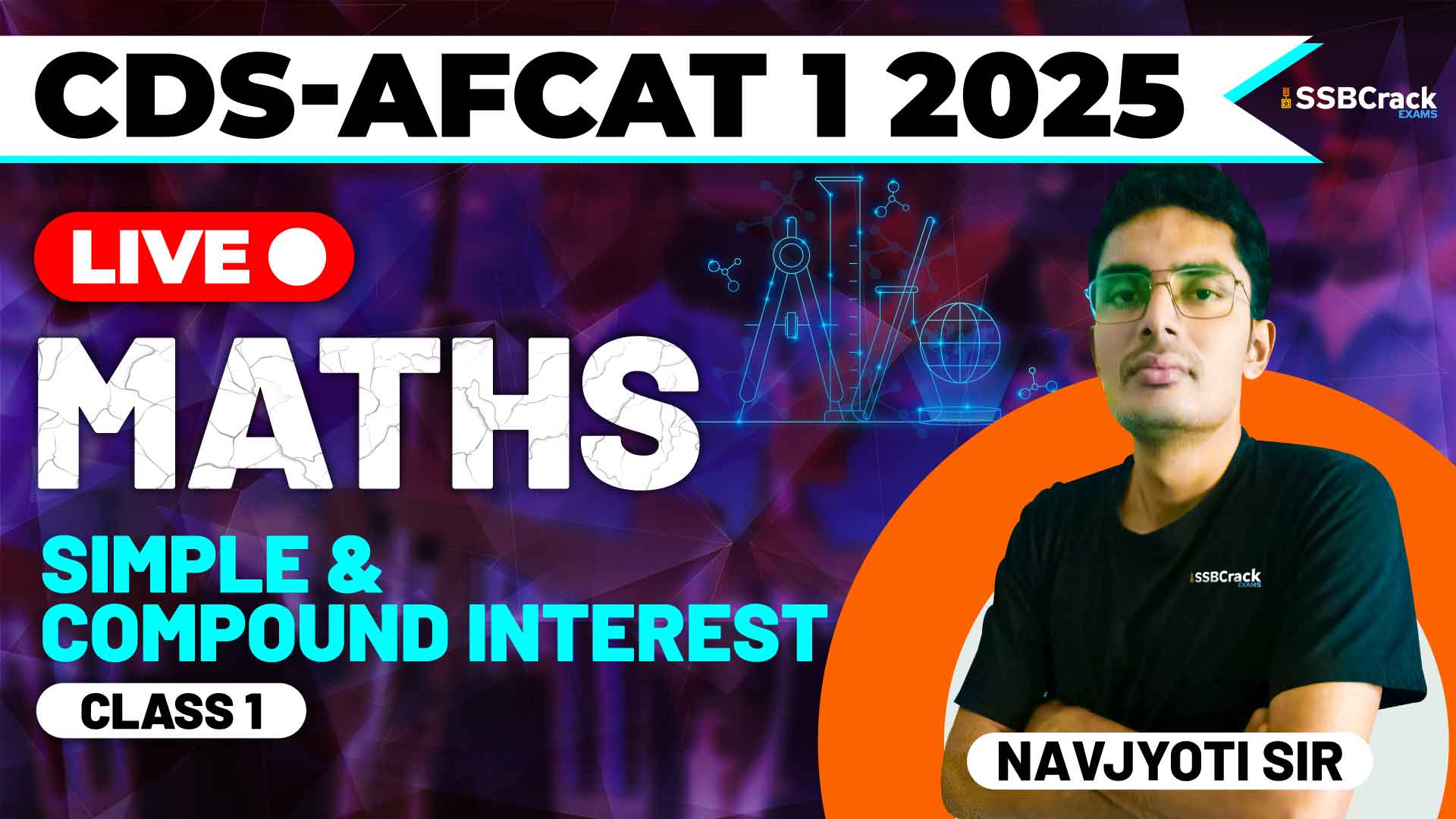In competitive exams like the Combined Defence Services (CDS) and Air Force Common Admission Test (AFCAT), questions on Simple Interest (SI) and Compound Interest (CI) form a crucial part of the mathematics section. These topics are considered relatively straightforward but require clarity of concepts and quick calculations. Recently, a class was conducted to explain these concepts, focusing on the basics such as principal, interest, the rate of interest, time, and the simple interest formula. In this blog, we will go over the core topics that were covered in the class and provide strategies to help you prepare effectively for the exams.
Key Concepts in Simple Interest and Compound Interest
1. Principal:
The principal refers to the initial amount of money that is borrowed or invested. All interest calculations are based on this sum. Understanding the role of the principal is crucial since both simple and compound interest formulas use this as the starting point.
2. Interest:
Interest is the extra amount paid by a borrower to a lender, or the return earned by someone who invests money. There are two types of interest commonly discussed in these exams: Simple Interest and Compound Interest.
3. Rate of Interest:
This is the percentage of the principal that is paid or earned as interest over a given period, typically a year. In most questions, the rate of interest is presented annually, but it can be adjusted for different time periods depending on the problem.
4. Time:
The time period is the duration for which the money is borrowed or invested. The interest is usually calculated for a specific period—monthly, quarterly, or annually.
Simple Interest (SI)
Simple Interest is the interest calculated on the original principal for the entire duration of the loan or investment. It remains constant, which makes calculations simple and straightforward. The total amount of interest earned or paid is directly proportional to the principal, the rate of interest, and the time. This linear relationship makes it easy to understand and solve questions quickly.
In the class, the instructor emphasized the importance of thoroughly understanding the relationship between the principal, interest rate, time, and simple interest. Questions in CDS and AFCAT exams typically revolve around calculating one of these variables when the other three are provided.
Types of Questions Discussed in the Class
During the class, several types of questions were discussed, focusing on both Simple Interest and Compound Interest. Here are some of the common question formats that were highlighted:
- Basic Simple Interest Calculation:
These questions are the most straightforward and usually ask you to calculate the interest earned or paid based on the given principal, rate of interest, and time period. These problems are simple and serve as the foundation for more complex interest-related problems. - Finding the Principal or Rate of Interest:
In some questions, the interest, time, and rate might be given, and you are asked to find the principal amount. Alternatively, the principal, interest, and time could be provided, and you’ll need to calculate the rate of interest. These questions test your ability to manipulate the basic relationships between these variables. - Compound Interest with Different Compounding Frequencies:
Compound interest problems often ask for interest calculations when the interest is compounded annually, semi-annually, or quarterly. Understanding how to adjust for different compounding periods is key to solving these problems quickly and correctly. - Difference Between Simple Interest and Compound Interest:
A common question type in CDS and AFCAT exams involves calculating the difference between simple interest and compound interest over a given time period. This type of question highlights how much extra interest is earned through compounding, and the calculations must be precise.
Strategies to Prepare for Simple Interest and Compound Interest
While Simple and Compound Interest are considered easier topics, mastering them can give you an edge in the mathematics section of CDS and AFCAT exams. Here are some strategies discussed in the class that will help you prepare:
1. Focus on Conceptual Clarity
Before diving into practice questions, ensure that you fully understand the underlying concepts of principal, interest, rate, and time. Learn how they are interrelated and how they affect each other in both Simple and Compound Interest calculations.
2. Practice Different Types of Questions
Since questions can range from simple interest calculations to more complex compound interest problems, make sure to practice a variety of question types. Start with basic problems and gradually move on to questions involving different compounding periods and mixed interest calculations.
3. Master Quick Calculation Techniques
In competitive exams, time is of the essence. Mastering shortcuts and mental math techniques can help you save valuable time during the exam. Practice calculating interest amounts quickly and accurately, especially when working with compound interest problems where time-consuming calculations are common.
4. Use Previous Year Papers
One of the best ways to prepare for any exam is by solving previous years’ papers. Go through the SI and CI questions from previous CDS and AFCAT exams to get a sense of the types of problems that are commonly asked. Pay attention to patterns and frequently repeated question types.
5. Stay Updated on Tricks for Compound Interest
Compound Interest problems often involve lengthy calculations. Learning a few tricks to simplify these can save you time. For instance, when interest is compounded annually, semi-annually, or quarterly, practice adjusting the rate of interest and time period accordingly.
6. Avoid Careless Mistakes
Many students lose marks due to small errors in reading the question or misinterpreting the given data. In questions involving Compound Interest, especially with different compounding periods, double-check your calculations to avoid such mistakes.
7. Time Management
During the exam, it’s important to allocate your time wisely. Simple Interest questions are generally quicker to solve, while Compound Interest may require more time. Practice solving these questions under timed conditions to develop a good sense of pacing.
Conclusion
Simple Interest and Compound Interest are important topics in the mathematics section of the CDS and AFCAT exams. A recent class on this topic emphasized the importance of understanding basic concepts like principal, interest, rate, and time, and how they apply to both types of interest calculations. While Simple Interest problems are straightforward, Compound Interest questions can be more complex, especially when different compounding periods are involved.
By focusing on building a solid foundation of the concepts, practicing different types of problems, and mastering quick calculation techniques, you can confidently tackle these questions in the exam. Remember to stay organized in your preparation and regularly solve previous year papers to familiarize yourself with the exam format. With consistent effort and effective time management, you’ll be well-prepared to ace the Simple and Compound Interest sections of your CDS and AFCAT exams.
Good luck!

















